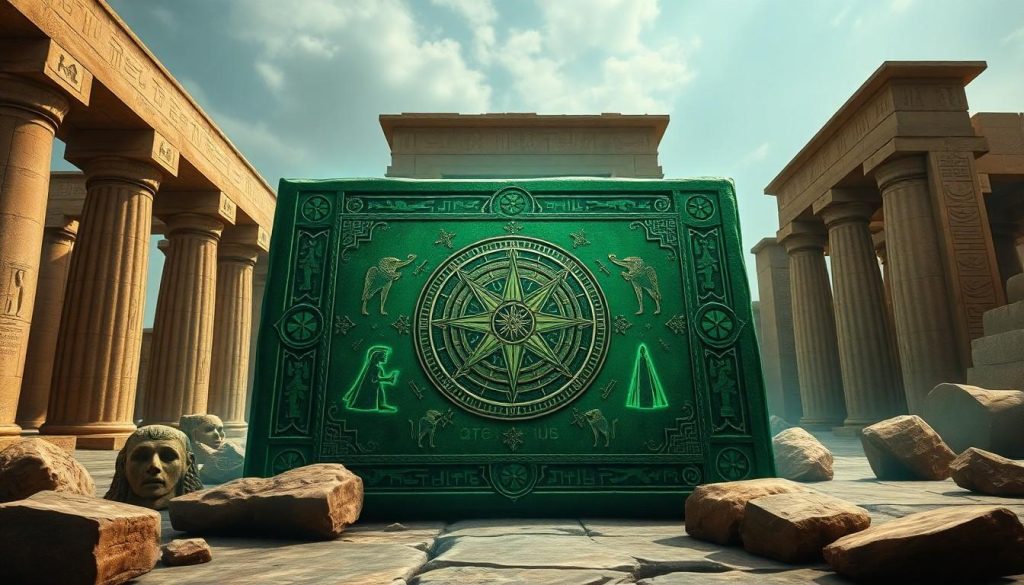The mysterious Emerald Tablets have captivated scholars, mystics, and history enthusiasts for centuries. These ancient artifacts allegedly contain profound wisdom from Hermes Trismegistus – a legendary sage believed to possess divine knowledge. While their physical existence remains debated, the tablets’ influence on alchemy, philosophy, and esoteric traditions is undeniable.
Dating back to an uncertain period between 1200 and 750 BCE, the tablets supposedly originated in ancient Egypt. Their contents were first translated from Arabic to Latin in the 12th century, sparking widespread interest across medieval Europe. The texts discuss metaphysical principles, cosmic laws, and the nature of reality – leading many to question whether such advanced concepts could emerge from ancient times.
The History and Origins of the Emerald Tablets
The Emerald Tablets first emerged in early medieval Arabic sources during the 8th and 9th centuries CE. These cryptic texts contain esoteric wisdom attributed to ancient Egyptian knowledge systems.
Ancient Egyptian Connections
Ancient Egyptian mythology links the Emerald Tablets to Thoth, the deity of wisdom, writing, and magical arts. The tablets incorporate Egyptian metaphysical concepts with Greek philosophical traditions, reflecting the cultural fusion prevalent in Hellenistic Egypt.
Hermes Trismegistus and Hermetic Texts
Hermes Trismegistus, a syncretistic deity combining the Greek god Hermes with the Egyptian god Thoth, is credited as the author of the Emerald Tablets. Academic research indicates Hermes Trismegistus is a mythological construct rather than a historical figure. The texts form part of the Hermetic corpus, a collection of philosophical and religious writings that emerged during the Hellenistic period.
| Period | Key Development |
|---|---|
| 8th-9th century CE | The earliest known Arabic versions appear |
| Late medieval period | Translation from Arabic to Latin |
| Hellenistic era | Original philosophical concepts develop |
Physical Description and Alleged Materials

The Emerald Tablet’s physical description comes from medieval Arabic and Latin texts, describing it as a compact inscription on an emerald or green stone tablet. The original artifact remains unverified, with no physical evidence supporting historical accounts.
Claims About the Emerald Stone
The legendary stone tablet contains encoded universal wisdom inscribed in ancient text. Historical accounts attribute these properties to the tablet:
- Emerald or green crystalline composition
- Cryptic text carved into the surface
- Alchemical formulas for the Philosopher’s Stone
- Sacred knowledge from Hermes Trismegistus
- Metaphysical principles of creation
Archaeological Evidence
No authenticated emerald tablets have been discovered in archaeological excavations or historical collections. The evidence surrounding the tablets consists of the following:
- Textual references in Arabic manuscripts from 8th-9th centuries CE
- Latin translations dating to the 12th century
- Descriptions in alchemical and hermetic texts
- References in medieval European writings
- Artistic depictions in illuminated manuscripts
The absence of physical artifacts leaves scholars to analyze the tablets primarily through surviving textual traditions rather than material remains. Documentation exists only in translated copies with no source material preserved.
Translation and Interpretation Challenges

The Emerald Tablets underwent multiple translations from Arabic to Latin, creating interpretive complexities that affect modern understanding. The textual evolution spans centuries and is significantly varied across different cultural contexts.
Multiple Historical Versions
The earliest documented translations of the Emerald Tablets emerged in Arabic texts during the 8th-9th centuries CE in the Kitab sirr al-Haliqi. Latin translations followed in medieval Europe, creating distinct interpretative lineages:
- Arabic Version (800-850 CE): Contains expanded metaphysical concepts with Islamic influences
- Latin Translations (1100-1200 CE): Introduced Western alchemical interpretations
- European Adaptations (1400-1700 CE): Added Christian mystical elements to the original text
- Modern Translations: Feature varied interpretations based on source manuscripts
Key Teachings and Symbolism
The translated texts contain recurring symbolic elements across versions:
- Alchemical Processes: References to transmutation principles
- Cosmic Laws: Descriptions of universal correspondences
- Natural Philosophy: Explanations of elemental relationships
- Metaphysical Concepts: References to spiritual transformation
- Language Barriers: Ancient technical terms lack modern equivalents
- Cultural Context: Original metaphors lose meaning across traditions
- Manuscript Variations: Different source texts create inconsistent interpretations
| Translation Period | Primary Language | Key Features |
|---|---|---|
| 8th-9th Century | Arabic | Metaphysical |
| 12th Century | Latin | Alchemical |
| 15th-17th Century | European | Mystical |
Scientific Analysis of the Tablets

Scientific analysis of the Emerald Tablets focuses on textual examination, material composition studies, and historical authentication efforts. Modern research techniques provide insights into the authenticity and origins of these ancient texts.
Modern Research Findings
Textual analysis reveals that Emerald Tablets contain complex alchemical theories, including the fundamental principle that metals form from sulfur and mercury combinations. Multiple translations, starting with the Arabic-to-Latin conversion in the 12th century, demonstrate evolving interpretations across different scholarly traditions. Notable researchers like Isaac Newton and Johannes Trithemius created distinct translations, contributing to the diverse understanding of the tablets’ content.
Dating Controversies
The dating of the Emerald Tablets presents significant challenges for researchers. Linguistic evidence from the earliest surviving Arabic manuscripts places the text’s documented existence between the 8th and 9th centuries CE. The absence of physical artifacts creates uncertainty about the tablets’ original creation date, while textual references suggest potential origins in Hellenistic Egypt. These chronological discrepancies complicate establishing a definitive timeline for the tablets’ emergence and transmission.
Historical Impact on Occult Philosophy
The Emerald Tablet’s influence on occult philosophy traces back to its earliest Arabic translations in the 8th century CE. These texts shaped medieval understanding of alchemy metaphysical principles.
Influence on Alchemy
The Emerald Tablet’s impact on alchemical practices stems from its cryptic formulas encoded in ancient Arabic manuscripts. Medieval alchemists interpreted the tablet’s teachings through translations by scholars like Hugo of Santalla, incorporating its principles into their experimental work. The text’s emphasis on the relationship between celestial macrocosm cosmic patterns influenced alchemical laboratory procedures throughout Europe.
Role in Esoteric Traditions
The tablet’s teachings became foundational to Western esoteric traditions by integrating into Hermetic philosophy. The attribution to Hermes Trismegistus, a syncretic deity combining Greek Hermes with Egyptian Thoth, established its authority in occult circles. The text appears in the Kitab sirr al-haliqi, demonstrating its significance in early Islamic esoteric writings during the 8th-9th centuries CE.
| Time Period | Key Development |
|---|---|
| 8th-9th century CE | The earliest Arabic versions appear |
| 12th century CE | Latin translations emerge |
| Medieval Period | Integration into European alchemy |
Separating Fact from Fiction
Modern research reveals significant discrepancies between the legendary status of the Emerald Tablets and verifiable historical evidence. Archaeological findings and historical documentation make the distinction between mythology and reality clearer.
Archaeological Perspectives
Archaeological investigations have found no physical evidence of the Emerald Tablets. Despite extensive excavations in ancient Egyptian sites where such artifacts might have been preserved, no emerald or green stone tablets matching the historical descriptions have emerged. This absence of material evidence contradicts the numerous accounts describing these tablets as physical objects.
Historical Documentation
The earliest documented references to the Emerald Tablets appear in Arabic texts from the 8th and 9th centuries CE. The texts attributed to these tablets exist in various written sources, primarily transmitted through medieval Arabic and Latin manuscripts. While these documents contain sophisticated philosophical and alchemical teachings, the physical tablets remain unverified by historical records or archaeological discoveries. The figure of Hermes Trismegistus, credited as the tablets’ author, exists as a mythological construct combining Greek and Egyptian deities rather than a historical person.
| Historical Aspect | Finding |
|---|---|
| Physical Tablets | No archaeological evidence |
| Earliest Documentation | 8th-9th centuries CE |
| Original Author | Mythological figure |
| Verified Artifacts | None discovered |
Bottom Line
The mystery of the Emerald Tablets continues to captivate minds across generations. While their physical existence remains unproven, the tablets’ profound influence on alchemy, occult philosophy, and esoteric traditions is undeniable.
The teachings attributed to these ancient texts have shaped centuries of metaphysical thought despite the absence of tangible artifacts. Whether the tablets existed as physical objects or vehicles for transmitting ancient wisdom, their impact on human understanding of cosmic laws and universal principles persists.
The enigma of the Emerald Tablets stands as a testament to humanity’s quest for more profound knowledge and understanding of the mysteries that connect our physical world to the spiritual realm.

